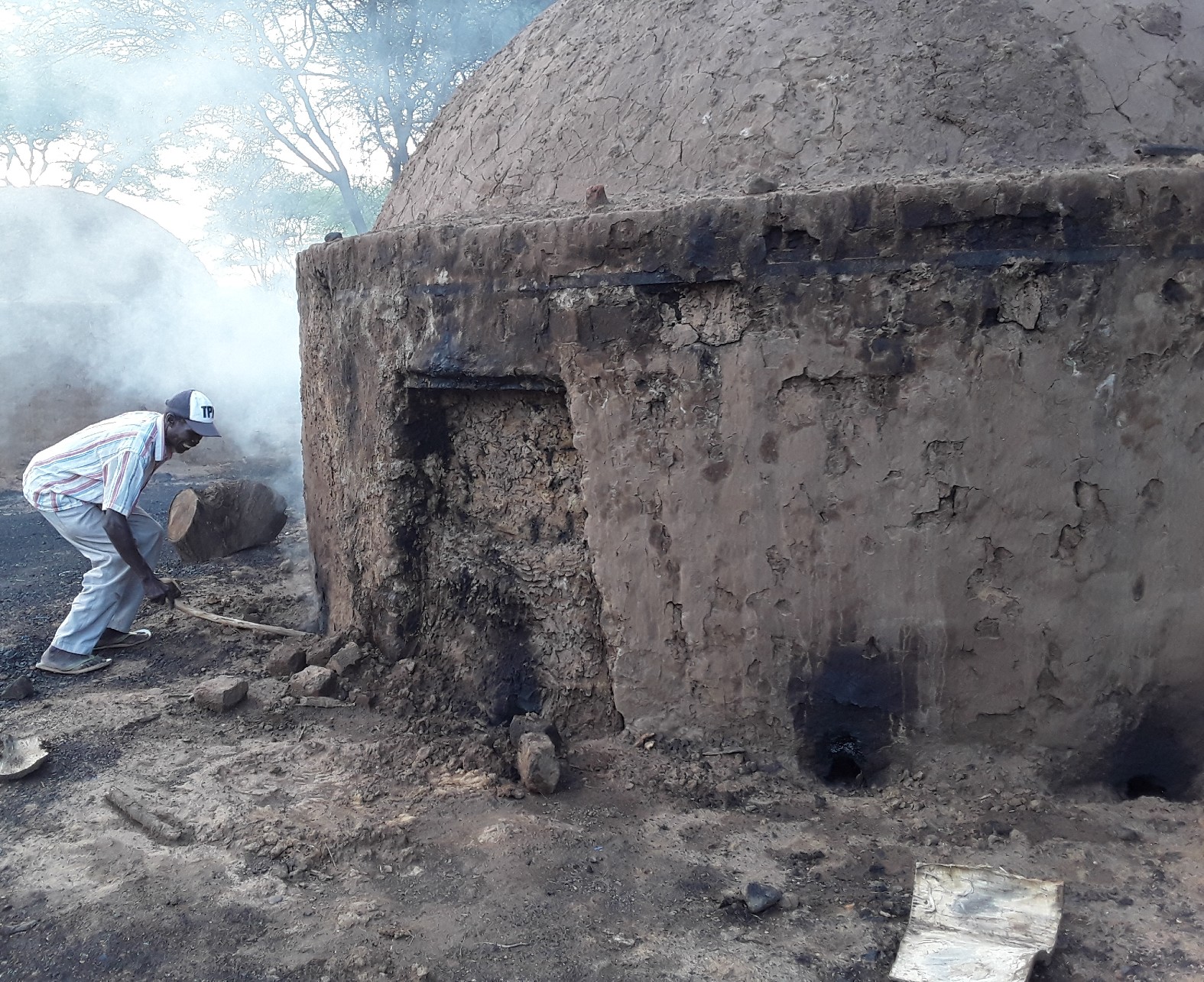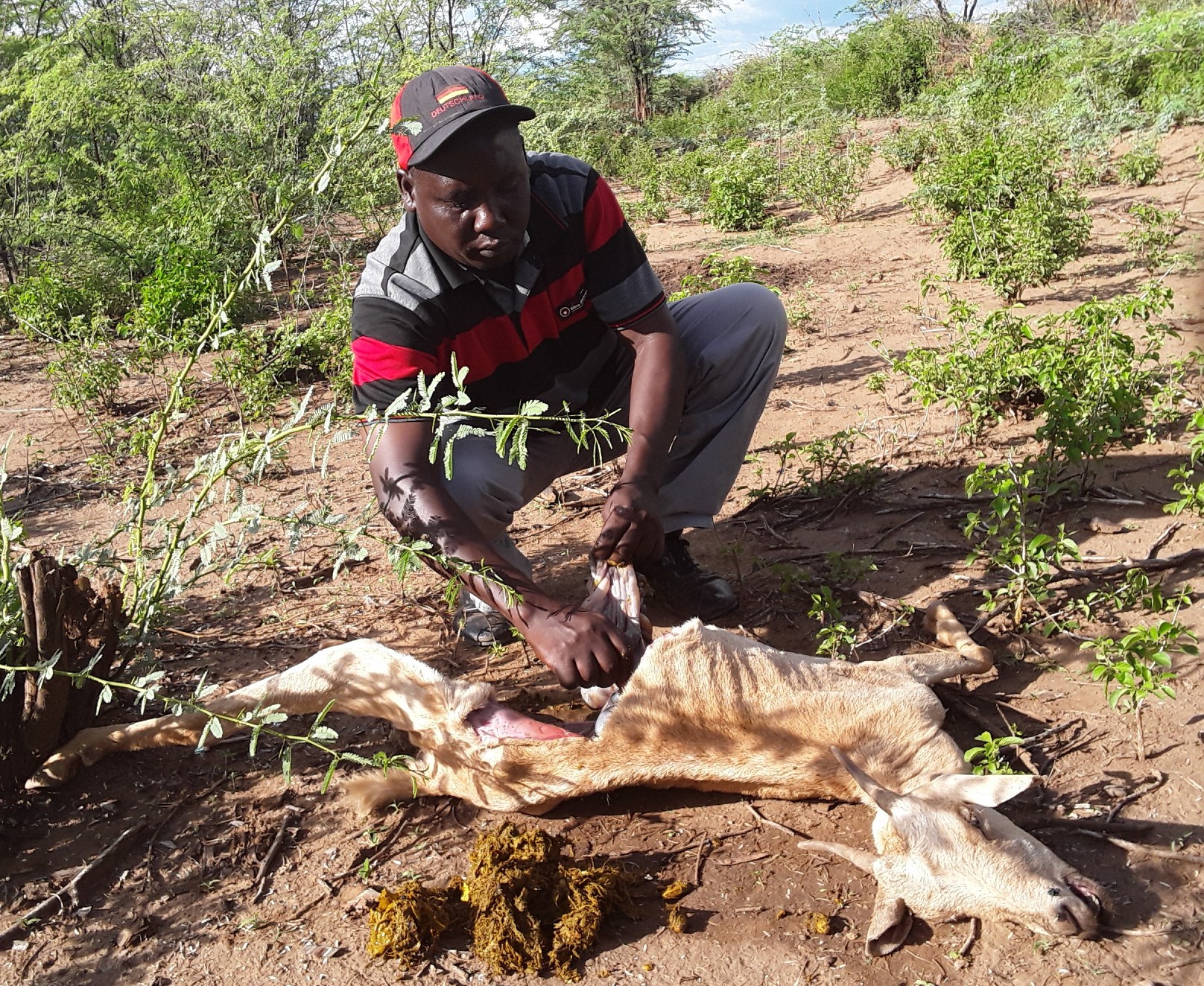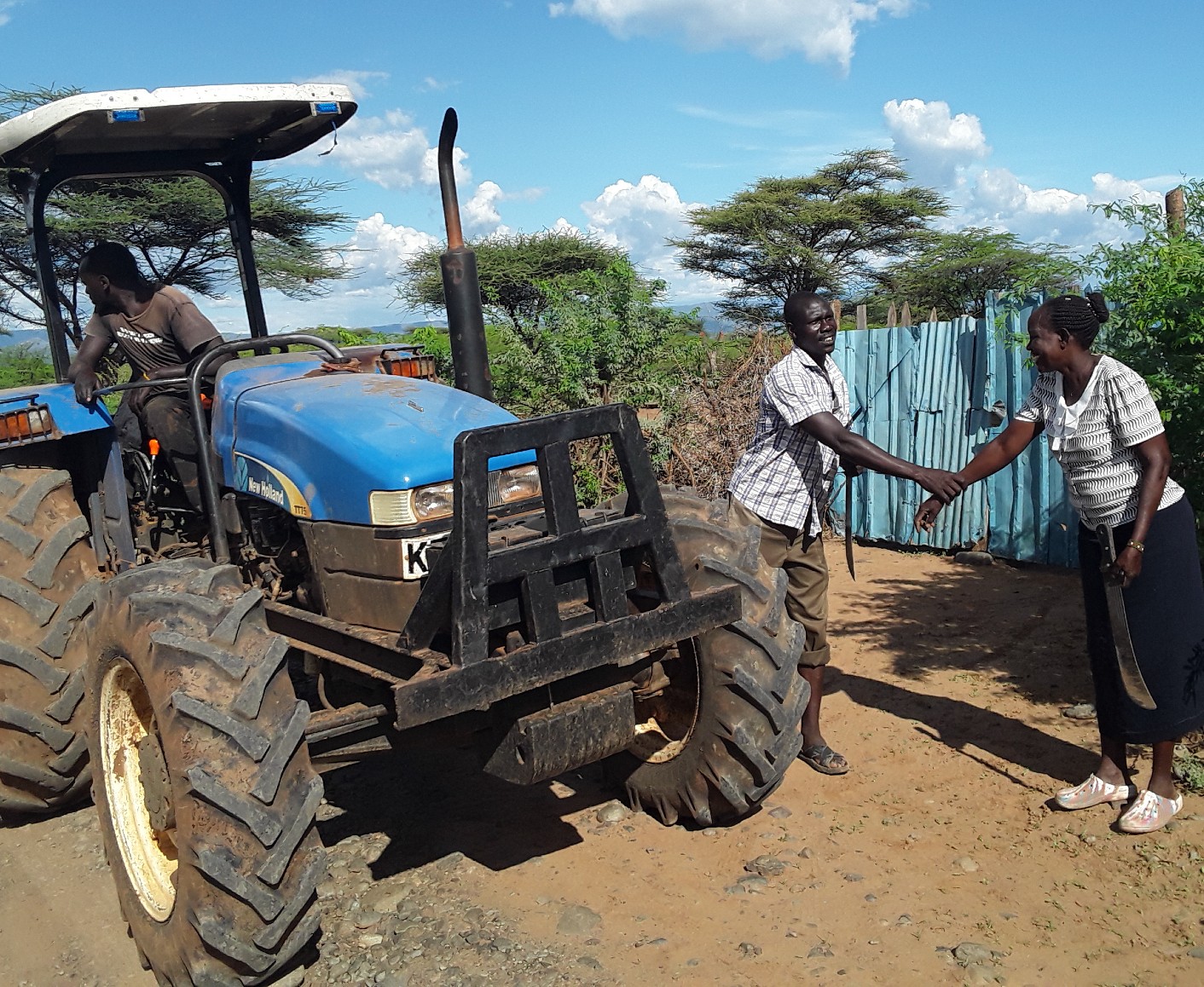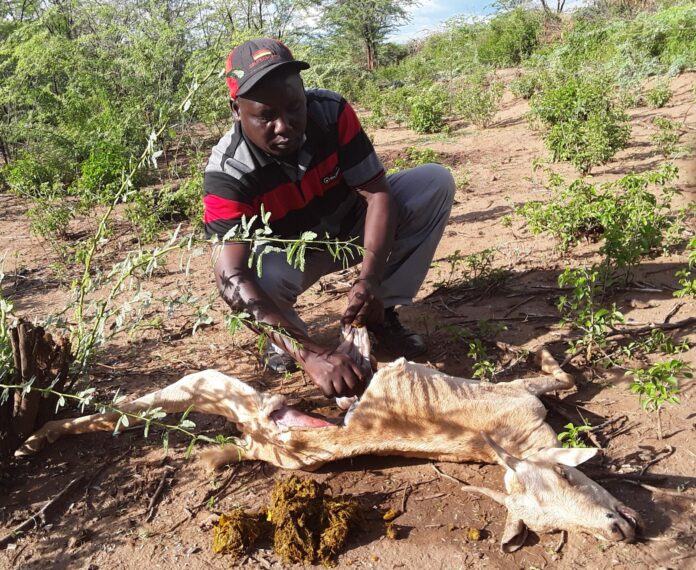By Joyce Chimbi
Bariongo County, Kenya: As the mouth shakes uncontrollably and an attempt to chew sends jaws sliding from side to side, the goat stands still, vomiting a thin dark green fluid. All signs that the end is near. Rispah Enenganai, the owner, watches helplessly. She has seen these signs too many times.
The swollen stomach is evidence of interrupted digestion. Before the week is over, her goat will die, for there is no doubt that the animal has consumed pods, the sweet but harmful fruits of the prolific and invasive Prosopis Juliflora, locally known as mathenge.
Enenganai is from the llchamus community, a minority ethnic group from Ndao village, Marigat sub-county in Baringo County. She says many of her neighbors have lost one or two goats in the last four months.
“Once you see a goat unable to close its mouth, it is a sign that death is calling. The pods have a lot of sugar which causes the teeth to decay and fall out of the mouth. Even without the teeth, the goat cannot chew because it loses control of its mouth, and you watch your goat starve to death,” Enenganai observes.

Simon Choge, a scientist at the Kenya Forestry Research Institute (KEFRI), specialized in natural resource management and social economic and policy, explains that “Mathenge is a drought-resistant wild invasive species, initially introduced in Baringo and other arid and semi-arid areas in Kenya as a solution. It provided an all-season vegetation cover, windbreak, shade, pasture, firewood, bee forage, human food, and stabilized soil in degraded areas.”
But the fast-growing and ever-green tree of tropical American origin quickly became a nightmare for the Pokot, Tugen and llchamus communities in the expansive Marigat sub-County, Baringo County.
Choge says Mathenge produces masses of pods; each pod contains 10 to 20 small seeds and is considered one of the world’s worst invasive plant species. Once eaten, these pods can cause neurotoxic damage in the central nervous system in cattle and goats, detrimental to these nomadic communities whose livelihoods depend on livestock.
KEFRI’s research reveals that Prosopis Juliflora spreads rapidly due to its powerful ability to regenerate in high density, and its extensive deep root systems, reaching the water sub-surface, consuming significant amounts of water and, especially in the dry season, make it impossible for it to co-exist with other vegetation.
“Mathenge grows everywhere, near and inside rivers, inside Lake Baringo and Lake Bogoria, in our schools, our homes, on the road. Wherever there is space, it will grow.” Josphat Marakis, a fisherman in Lake Bogoria, explains. Our fish is deformed because once it grows inside the lake, its sharp thorns poke the eyes of the fish. Such a harsh environment where fish cannot swim freely is not good for the fish population. The fish can easily swim away to other areas that are safer for them.”
Samwel Montorosi, Chairperson of the Charcoal Producers Association in Baringo County, in Salabani village, says the community is also at great risk of injury from the dangerous thorns.
“Left untreated, the injury can lead to amputation. It is very hard to control the tree because our children enjoy eating pods. They chew the pods, suck out the sugar, and spit out the seeds. Livestock also passes out the seeds as waste. Once the seeds find their way into the soil, they grow in just a few weeks,” he says.
Choge says the first herbarium specimen-a collection of preserved plant specimens maintained for scientific purposes- was collected in 1977 in Kenya’s coastal region. By 2006, the Pokot, Tugen and llchamus indigenous communities had realized that mathenge was not an ally.
“Mathenge was taking too much from us and destroying our lives. There were long-standing problems in the community among the ethnicities in the area. Mathenge made the situation worse,” says Jonathan Mitei, Chairperson of Lokasacha Charcoal Producers Association and a member of the Tugen ethnic group.
“We are all pastoralists, competing for water and pasture and competing with mathenge. Mathenge was too powerful. So, we started to unite in search of a solution,” he adds.

In 2006, the llchamus community, one of the smallest indigenous communities in Kenya, sued the Kenyan National Government for compensation for introducing the destructive wild invasive species into the community. The lawsuit was also supported by their neighbors, the Pokot and Tugen, another two marginalized indigenous communities in Marigat who have similarly been on the frontlines of bearing the brunt of the invasive weed.
Mathenge’s impenetrable thickets had extensively out-competed indigenous vegetation, destroying local biodiversity and livestock and paralyzing their pastoral economies. Montorosi and Mitei were both involved in the lawsuit, which they say was a cry for help from a cornered pastoral community, lashing out at the Government for not conducting an environmental impact assessment before rolling out what turned out to be a destructive and unrelenting invasive enemy.
Overall, the community petitioned for a declaration that the Government is directly liable for the loss occasioned to the petitioners and other residents of the Marigat Sub-County of Baringo County by introducing the weed. This petition was granted by the High Court in 2007.
The community also wanted the weed to be declared noxious in the same category as other weeds set out in the suppression of Noxious Weeds Act cap 325 Laws of Kenya. This aspect of the petition was also granted. In 2008, the National Government declared mathenge a noxious weed and, therefore, harmful to the environment.

In the 2007 High Court Ruling Judgement in the CHARLES LEKUYEN NABORI & 9 OTHERS v ATTORNEY GENERAL & 3 OTHERS [2007] eKLR case, the court further directed that a commission comprising technical and local experts be appointed by the National Government under terms and references set out by the High Court.
The High Court could not award damages because it was impossible to determine how much loss and damage was caused by the invasive weed. The commission would therefore assess damage to the community and table its findings.
Following the transition of Government from the 2007 elections, the issue of assessing loss and damage towards compensating the community was never revisited. The Ilchamus Council of Elders remains relentless in the quest to find justice. In 2016 and 2018, they publicly threatened to sue the National Government for a second time to receive compensation from the National Government in line with the High Court case they won against it in December 2007.
Meanwhile, in recent years, Montorosi states that the Government through KEFRI, has accelerated efforts to control the prolific weed by urging the community to use mathenge as firewood and to leverage the wild species to generate a booming charcoal production.
“We established at least seven multi-ethnic run charcoal production associations across Marigat sub-county. This was a very good idea, but there were problems. People were used to consuming charcoal produced from trees such as acacia which produces high-quality charcoal. But burning such trees for charcoal is illegal,” says Ben Rotich, a Salabani Charcoal Producers Association member.
“We were not producing good quality charcoal using mathenge because we used trees that had not matured. But now we know how to produce good charcoal using mathenge. We have not received any complaints from consumers over the quality of charcoal produced using mathenge because we only use mature mathenge trees.”
Rotich understands the charcoal business. He manages two charcoal production kilns that produce 200 bags of charcoal every three weeks. Each bag weighs 60 kg, and within Baringo County, one bag of charcoal sells at US$6 (KSh 762). In Nairobi, the same bag goes for US$23 to 30 (KSh 2,921 -3,810).
But despite the gap in the government’s commitment to the 2007 ruling and, in particular, the lack of compensation for damage and loss from Prosopis Juliflora and ongoing efforts by the llchamus Council of Elders to pressure the government for compensation. The communities have employed some solutions to this pervasive threat. They have chosen to take up agro-pastoralism. The community now understands that the Prosopis Juliflora species thrives in unused sparse land.
In Marigat, pastoralists are now embracing agriculture, their new double-edged sword to secure food and subdue the invasive species.
Baringo County is in the Rift Valley, Kenya’s food basket. Baringo is home to Lake Bogoria, one of two freshwater lakes in Rift Valley. Lake Baringo is fed by three rivers and is ideal for farming.
Today, Jane Parsalach, a farmer in Ndao village, says that while mathenge is still a menace, the story of Prosopis Juliflora is changing, and the community has found the remedy.
“In this village, many of us are now farmers, and we have managed to control mathenge. We have received training from the Government and now understand that it is no longer possible to remove Mathenge completely, but we can live with the plant in a manner that is healthy and beneficial to use,” Parsalach explains.
Currently, many farmers are growing maize, vegetables such as kale, and animal feed for subsistence use. But some, like Parsalach, grow animal feed for sale on three acres of land. The journey to agro-pastoralism is now irreversible.
“As pastoralists, we have seen the many benefits of farming. In this village, we have a C.B.O [community-based organization] that is working with the Government to give us water for irrigation. When we grow crops like maize, we put food on the table, and our animals have enough pasture,” says Parsalach.
Pauline Chelagat, another farmer from Kailer village in Marigat, nearly 50 kilometers from Salabani village, says the community needs support.
“We have big farms, but we are only farming on a small part of it because it is very difficult to clear mathenge. It is too deep-rooted, and we are spending a lot of money to clear it off.”
Chelagat says a landowner can pay labourers to uproot Prosopis Juliflora at US$3 (KSh 381) per person working from eight in the morning to six in the evening, or payment can be based on the number of Prosopis trunks uprooted costing between US$0.5 to US$3 (KSh 63 to 381) depending on the size of each trunk.
“Either way, you will pay at least US$200 (KSh 25,400) per acre. So, farmers are only clearing small areas because they cannot afford to do more. But if we were to be given free tractor services by the Government to uproot mathenge, we could use larger portions of land. Those who can afford to hire tractors are farming on several acres of land, but many of us are struggling,” she says.
Even as threats of a second lawsuit continue, Montorosi and Mitei confirmed that the National Government continues to work closely with the community to control the invasive weed. Community members, through their chiefs, made a joint decision to collaborate with the government to find workable, sustainable solutions.
Moving towards a solution, the community is now involved in developing the first-ever National Strategy and Action Plan for the Management of Prosopis Juliflora in Kenya. The national strategy proposes four main approaches, biological, chemical, utilization and mechanization, towards the effective management of mathenge. Used in combination, Choge says this is the silver bullet that will effectively subdue the wild invasive species in the long term.
The biological method involves using a particular breed of pests that can ravage the ever-green Prosopis plant, and trials are already underway. The chemical method involves spraying chemicals that are only harmful to the plant in a localized manner, and tests are also ongoing at Government institutions such as KEFRI.
The utilization method is whereby the community cuts down mathenge trees for charcoal production, firewood, and fencing. The mechanization method involves removing mathenge using machinery such as tractors.
“The mechanical method is in use and is working very well, but the community needs support to either acquire necessary machinery to uproot these plants or to be provided with free services,” says Dennis Kipchemoi, a teacher and farmer at Kailer village, Marigat.
“After all, the Suppression of Noxious Weeds Act (CAP 325) states that you can be forced to remove mathenge from your land by the Ministry of Agriculture, or the Ministry can have it removed for you,” he says.
In the community, the utilization method uses mathenge as firewood for furniture, fencing, charcoal production, and minor construction.
Combined, all four methods assure the community that the worst is behind them.
Enenganai says it used to be at least one dead goat per village daily. Today, it is one goat per village in so many weeks.
“We are losing fewer and fewer livestock because many of us can produce our own pasture and control what our animals eat. Agriculture is working, and the current drought has spared us,” she expounds.
Like many in the expansive Marigat Sub-County, Enenganai is confident that Marigat is slowly becoming a benchmarking site for neighboring pastoralist counties corned by Prosopis Juliflora and desperate to find a way out. At the same time, an indigenous community’s quest for justice in compensation for loss and damage due to introducing an exotic weed without an environmental assessment continues.
This story was produced with support from the Internews Earth Journalism Network.














